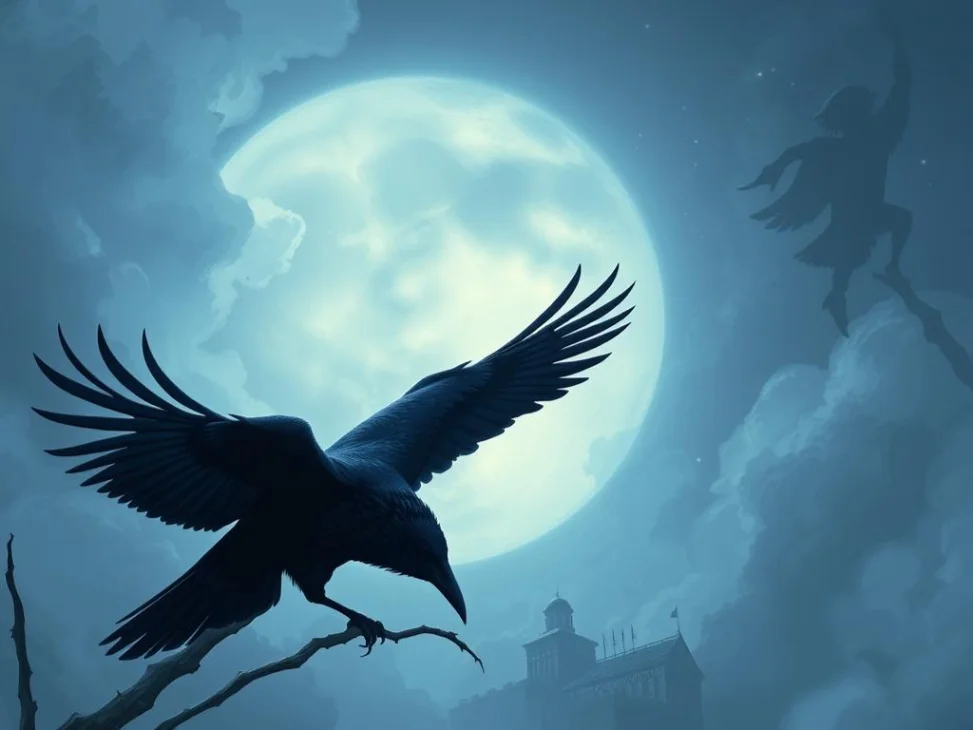The raven has long captivated human imagination, soaring through mythology, folklore, and spiritual traditions across the ages. Its mysterious black feathers, haunting vocalizations, and keen intelligence have inspired awe and bewilderment. What does the raven symbolize? Why is it such an enduring figure in cultural and spiritual contexts? While some view the raven as a harbinger of ominous events, others celebrate it as a symbol of intellectual depth, transformation, and insight.
Those intrigued by animal symbolism and spiritual meaning will be fascinated by the profound significance this bird holds across cultures. Whether it’s the Norse god Odin’s wise companions Huginn and Muninn or the Native American reverence for ravens as creators of the world, this creature embodies a rich tapestry of meanings. To dive deeper into the raven’s mysterious allure, visit for more insights animalsymbolism.org into the symbolism of various animals.
Key Symbols and Meanings of the Raven
- Wisdom and Intelligence – Ravens are known for their remarkable intelligence. Across many traditions, they symbolize mental acuity, problem-solving, and the journey toward enlightenment.
- Transformation and Change – Their dark plumage is often associated with mystery and transformation, offering guidance through personal growth and spiritual evolution.
- Messenger Between Worlds – In mythology, ravens often act as intermediaries, bridging physical and spiritual realms. They carry messages from gods or spirits.
- Prophecy and Omens – Whether as harbingers of doom or blessings, ravens have an uncanny knack for foretelling events, making them mysterious yet awe-striking figures.
The raven, with its versatile symbolism, appears in various cultural, spiritual, and mythological contexts. Each interpretation brings a unique layer of meaning to this enigmatic bird.
The Raven in Culture, Spirituality, and Mythology
Cultural Symbolism
Ravens have held diverse meanings in cultures across the globe. In Celtic mythology, the raven is associated with war and fate. The Celtic goddess Morrigan, often linked to ravens, sometimes takes their form as she oversees battlefields. Here, the bird represents not only death but also the cyclical nature of life and rebirth.
In Native American cultures, one of the most prominent symbols of the raven represents creation and transformation. As part of their storytelling traditions, ravens often play trickster figures or creators of the world. For instance, the Tlingit and Haida tribes of the Pacific Northwest believe a raven was responsible for coaxing light into the dark, primordial world—a representation of wisdom overcoming ignorance.
By contrast, many ancient European traditions viewed the raven with trepidation. Its black feathers symbolized the unknown, and its scavenger nature sometimes tied it to ominous events like plagues or war. However, this wasn’t always a bad thing; some believed that seeing a raven before a battle was a sign of triumph.
Spiritual Significance
From a spiritual perspective, the raven is often seen as carrying messages from the divine or guiding souls on their spiritual journey. Their ability to exist in liminal spaces—both high in the sky and on the ground—resonates with those traveling between physical and spiritual planes.
In shamanic traditions, ravens are spirit guides or totem animals representing deeper truths. If ravens repeatedly appear in your life, they might be encouraging you to reflect more deeply, tap into your intuition, or undergo a meaningful transformation.
For individuals practicing modern spirituality, seeing a raven could be a nudge to embrace new perspectives or heed intuitive warnings. Their watchful gaze and clever behavior remind us to stay alert to opportunities for growth and insight in our own lives. Are you ignoring your gut instinct? The raven might be asking you to trust it.
Mythological Connections
Ravens have a profound place in mythology, often appearing alongside gods, heroes, or spirits. Here are examples of their mythological importance in five traditions:
| Culture | Role of the Raven |
|---|---|
| Norse Mythology | Ravens Huginn (“thought”) and Muninn (“memory”) accompany Odin, bringing him knowledge of the world. They symbolize wisdom and divine insight. |
| Greek Mythology | Linked to Apollo, ravens once had white feathers but turned black as punishment for revealing bad news. They remind us to handle knowledge with care. |
| Native American | Creator and trickster figures among tribes like the Haida. The raven brings light to the dark world, symbolizing creation from chaos. |
| Celtic Culture | Sacred to the goddess Morrigan, ravens appear as omens of battle, embodying death, rebirth, and fate. |
| Christianity | In the Bible, ravens are associated with survival and divine provision, such as the ravens that fed Elijah. They reveal God’s mysterious ways of caring. |
Through these mythologies, the raven’s symbolic role crystallizes: it is not a passive onlooker but an active participant in the story of life, wisdom, and transformation.
What Can the Raven Teach Us?
How does the raven’s symbolism manifest in our daily lives? Its intelligence and resourcefulness remind us to stay adaptable and curious. For example, ravens have been observed using tools and solving puzzles in the wild. Spiritually, this can inspire us to approach difficult situations with creativity and inventive thinking.
The raven’s role as a messenger between worlds nudges us to pay attention to signs and symbols in our environment. If you see or dream of a raven, it might indicate an opportunity for reflection or impending spiritual growth. Are you facing a life-altering decision? Perhaps the raven has arrived to help guide you by urging you to trust your inner wisdom.
Additionally, its association with change and transformation can motivate us to shed old beliefs or habits that no longer serve us. Just like the raven thrives both on the ground and in the skies, we too can adapt and flourish in multiple realms of life.
A Story of Reflection
Consider the famous poem The Raven by Edgar Allan Poe. The bird, perched as an unyielding figure in the narrator’s chamber, repeats the word “Nevermore,” embodying themes of grief, wisdom, and the pursuit of truth. Though ominous, the raven becomes a symbol of acceptance, reminding us that some questions may never have answers, but we press forward nonetheless.
In this way, the raven teaches us resilience, the ability to embrace life’s mysteries without fear, and the courage to face transformation head-on. What mysteries linger in your life—are you ready to bring light to the shadows, like the raven has done in so many stories?
Conclusion
The raven transcends its status as a mere bird, becoming a profound symbol rich with meaning in human culture, spirituality, and mythology. Whether as the cunning messenger of the Norse god Odin or the transformative trickster of Native American lore, it challenges us to rethink what we know and embrace the unknown.
By delving into the raven’s significance, one can uncover lessons about intuition, intelligence, and personal growth. When viewed not as an omen of fear but as a guide for self-awareness and transformation, the raven becomes less of a mystery and more of a truth-bearer.
What does the raven mean to you? Is it a reminder of wisdom, an omen of change, or a guide between worlds? Whatever its message, the raven invites us to listen closely and tread boldly into the depths of the unknown.

